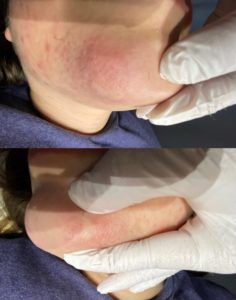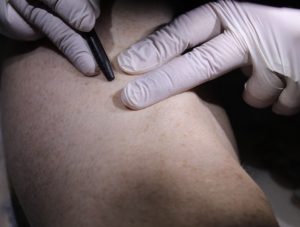Body Hair Conflict?
Body Hair
As human beings, we seem to be constantly in conflict with ourselves, especially when it comes to body hair. We wage a seemingly unending war with the hair our bodies produce. Either we don’t have enough hair or we are bothered by too much and we are comfortable.
For many, body hair is a top push and pull. We want hair, but on the other hand, we don’t want it.
A Hair-raising conflict

Woman shaving face
While hair is a protective measure, over time our environment has changed and hair is not as key as it was in the earlier stage of human evolution. Humans are now in a battle with the hair on their bodies.
Now, men spend hours of their lives shaving the hair that grows on their faces. But at the same time, they pull out all the stops to get hair replacements (plugs) or wear toupees (hairpieces) when they start losing the hair on the top of their heads.
According to an article on shaving statistics, the average guy spends about 4 months of his life shaving. And, sticking to the average, a blog in The Shaving Shack figures that a man shaves off more than 27 feet of facial hair throughout his lifetime.
Women are even more consumed by body hair conflict. They hide the hair loss atop their heads when it begins thinning or balding using wigs and hair extensions. But they spend an inordinate amount of time shaving, plucking, tweezing unwanted hair on other parts of their bodies. Legs, underarms, chin, lips, as well as pubic areas, are not spared.
On average, women spend about 72 days of their life shaving their legs, according to the article on shaving statistics. This leaves out uncountable hours spent on the other parts of their bodies that include the eyebrows, face, thighs, abdomen, breasts, and legs.
Electrolysis
For the men and women who are uncomfortable with unwanted body hair, there is electrolysis which is a permanent hair removal process. The benefit of the electrolysis treatment is that once treatments are completed, individuals are free to focus on living.
Unlike shaving, tweezing, plucking, and waxing, electrolysis treatment is not a lifetime commitment. Depending on which part of the body is being treated, it can take 15 minutes to an hour to do one treatment that will. And the number of treatment sessions needed depends on the individual.
An electrolysis treatment on the leg
Generally, electrolysis treatments can be done in eight to 12 sessions to permanently get rid of the unwanted body hair. While all types of hair can undergo electrolysis, thicker and denser the hair might require more sessions.
Hair on the body can be our hero
There are several theories about the role of body hair in human evolution. The color of our hair was a way to camouflage us against predators. Hair also helps protect the health of our skin. The hair follicles are coded with stem cells that stimulate the healing of a cut or wound. It also shields the skin from harmful sun damage.
And of course, body hair helps keep you warm. That’s why people in cold areas tend to gravitate to fur, which keeps animals warm.
Shedding unnecessary body hair
Over time, the need for thick body hair lessened, becoming more of a problem than a benefit.
Scientists have come up with several possibilities about why humans shed most of the thick hair that covered their bodies.
According to HowStuffWorks, one theory is that early man was a water-dwelling ape, and less body hair worked better suited in his aqueous environment. Another explanation was that man adapted to prevent the spread of parasites and thick fur was an accommodating nest. Other scientists say that when early men began walking on two feet, they no longer had full-body exposure to the sun.











